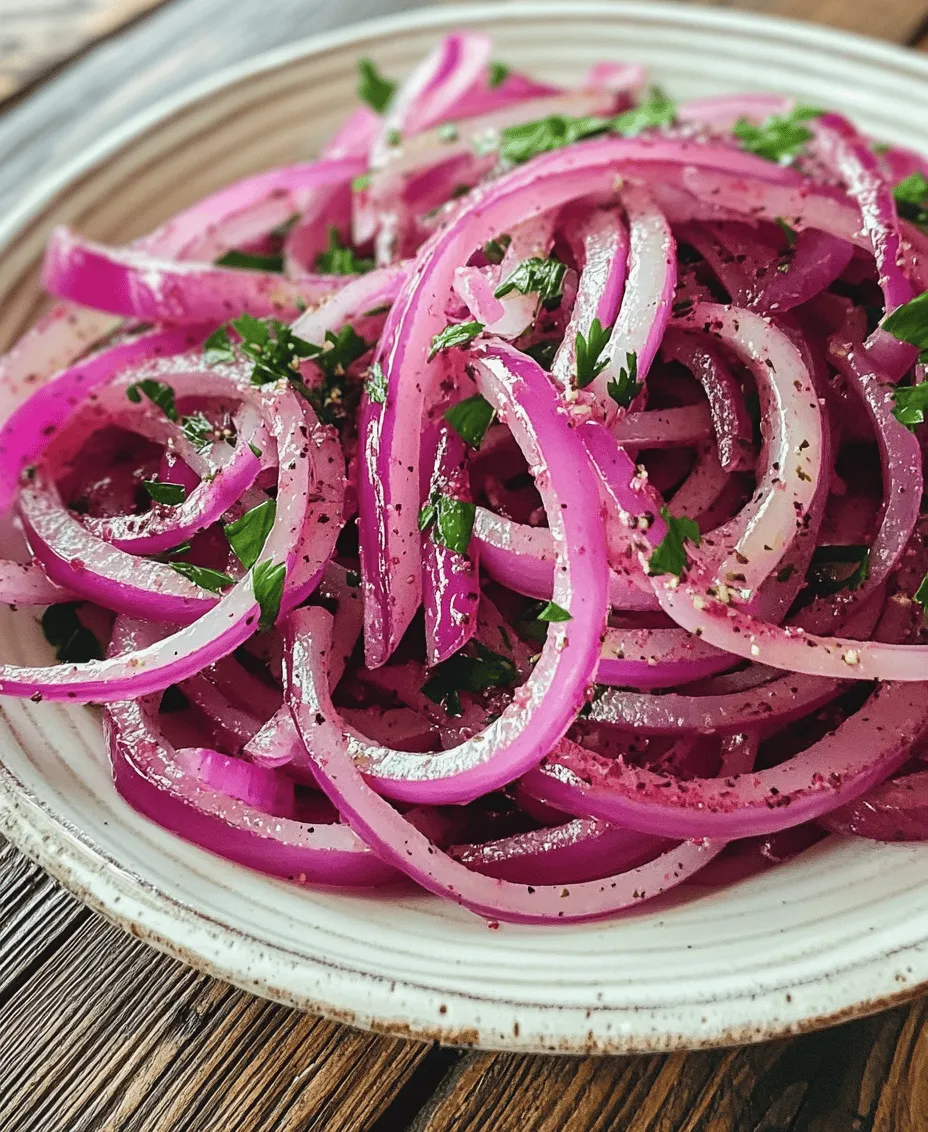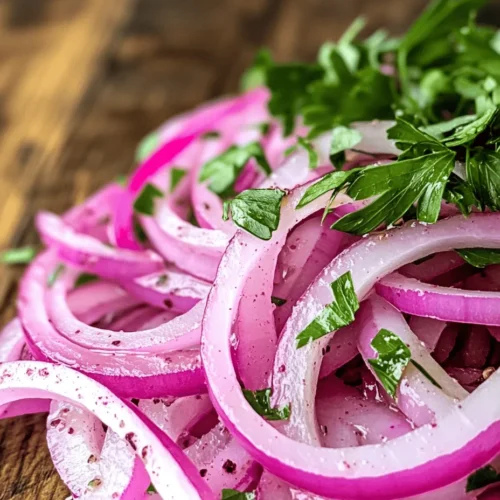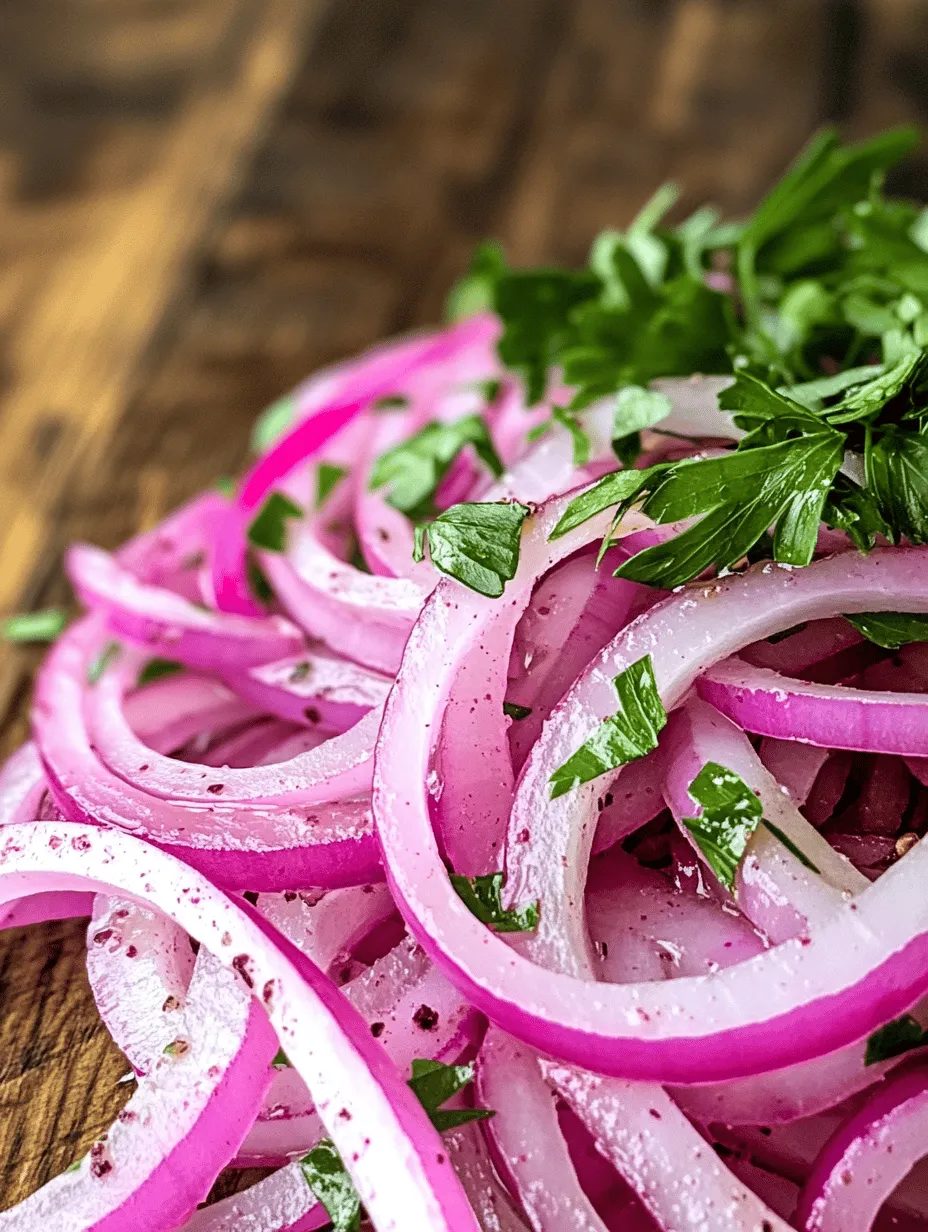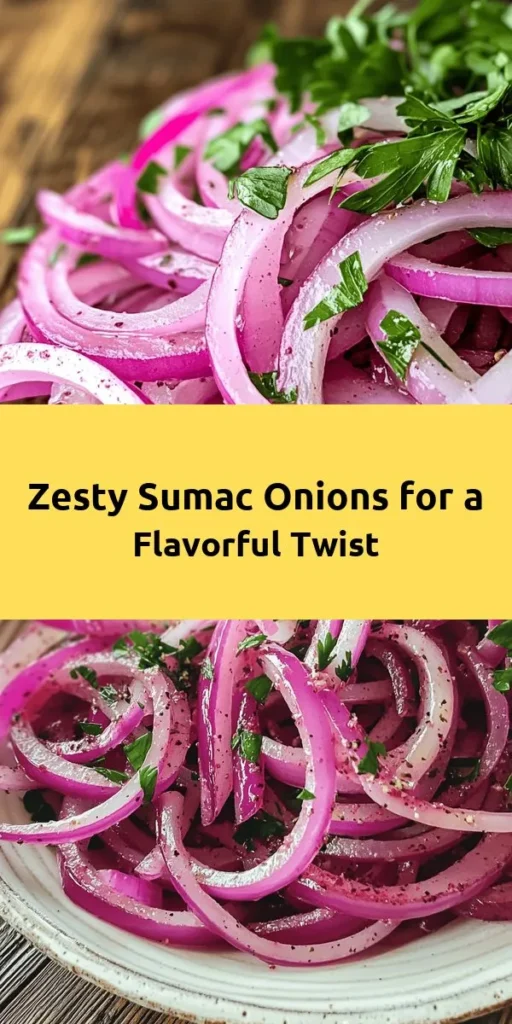In the world of culinary delights, few dishes can elevate the dining experience quite like a vibrant plate of Tangy Sumac Onions. This dish is not just a side; it’s a flavor explosion that can transform a simple meal into something extraordinary. The combination of red onions, sumac, and a handful of other ingredients creates a medley of tastes and textures that invigorate the palate. Whether you’re looking to enhance a salad, serve as a topping for grilled meats, or add a zing to your favorite sandwiches, Tangy Sumac Onions are the perfect accompaniment.
At the heart of this dish lies sumac, a unique spice that brings a tartness reminiscent of lemon, offering a refreshing twist to traditional onion preparations. Originating from the Middle East, sumac has been a staple in various cuisines for centuries. Its deep red hue and tangy flavor make it an intriguing addition to any dish, and it pairs beautifully with the sweetness of red onions. The preparation of Tangy Sumac Onions is not only simple but also quick, making it an ideal recipe for both novice cooks and seasoned chefs. Plus, the ingredients used are packed with health benefits, making this dish a wholesome addition to your table.
Understanding the Ingredients: A Closer Look at Each Component
To truly appreciate the deliciousness of Tangy Sumac Onions, it’s essential to delve into the individual ingredients that make up this flavorful recipe. Each component contributes not only to the taste but also to the nutritional value of the dish.
The Role of Red Onions in the Recipe
Red onions are the star of this recipe, providing a sweet yet slightly sharp flavor that pairs perfectly with the tanginess of sumac. When sliced thinly, red onions maintain a delightful crunch, adding texture to the dish. Nutritionally, red onions are rich in antioxidants, particularly quercetin, which is known for its anti-inflammatory properties. Additionally, they contain various vitamins, including vitamin C and B vitamins, which contribute to overall health and well-being. Their vibrant color is also a sign of their rich nutrient content, making them a beautiful addition to any plate.
The Essence of Sumac: A Spice Like No Other
Sumac is a spice that stands out in the culinary world, both for its flavor and its unique origins. Derived from the dried and ground berries of the sumac plant, this spice is commonly used in Middle Eastern cuisine. Its tart, lemony flavor enhances a variety of dishes, making it a versatile ingredient in the kitchen. Beyond its culinary appeal, sumac also boasts several health benefits. It contains antioxidants that may help reduce inflammation and promote heart health. Incorporating sumac into your meals not only adds flavor but also offers a boost to your wellness routine.
The Importance of Olive Oil
Olive oil plays a crucial role in the preparation of Tangy Sumac Onions, acting as a carrier for the spice and enhancing the overall flavor profile of the dish. The type of olive oil used can significantly affect the taste; for instance, a robust extra virgin olive oil will impart a stronger flavor compared to a lighter, more neutral oil. Olive oil is celebrated for its healthy fats, particularly monounsaturated fats, which are known to support heart health and reduce the risk of chronic diseases. Furthermore, olive oil is rich in antioxidants, making it a smart choice for cooking and drizzling over salads.
The Zing of Apple Cider Vinegar and Fresh Lemon Juice
The addition of apple cider vinegar and fresh lemon juice brings a bright acidity to the Tangy Sumac Onions, balancing out the sweetness of the onions and the richness of the olive oil. Apple cider vinegar is not only flavorful but also offers numerous health benefits, including improved digestion and detoxification properties. Fresh lemon juice enhances the dish’s brightness, providing a refreshing contrast to the other flavors. Both ingredients work together to create a harmonious blend that elevates the dish to new heights.
The Optional Sweetness of Honey
To round out the flavor profile of Tangy Sumac Onions, honey can be added as an optional ingredient. The natural sweetness of honey balances the acidity from the vinegar and lemon juice, creating a well-rounded flavor experience. Honey is also known for its potential health benefits, including its antioxidant properties and its role in soothing inflammation. For those seeking alternatives to honey, options like agave syrup or maple syrup can provide the same sweetness without compromising the dish’s integrity.
Fresh Parsley: A Garnish with Benefits
Finally, fresh parsley serves as both a garnish and an ingredient in Tangy Sumac Onions. Its bright green color adds visual appeal, while its fresh, herbal flavor enhances the overall taste of the dish. Nutritionally, parsley is a powerhouse, packed with vitamins A, C, and K, as well as minerals like iron and potassium. This humble herb not only beautifies the dish but also contributes to its health benefits.
Step-by-Step Guide to Preparing Tangy Sumac Onions
Now that we have explored the vibrant ingredients that come together to create Tangy Sumac Onions, it’s time to dive into the preparation process. This step-by-step guide will help you replicate this delicious recipe in your own kitchen, emphasizing key techniques and tips for the best results.
Preparation: Slicing and Salting the Onions
The first step in preparing Tangy Sumac Onions is to slice the red onions. It is essential to slice them thinly to ensure that they absorb the flavors of the dressing effectively. Here’s how to do it:
1. Peel the Onions: Start by peeling the outer skin of the red onions. Discard the skin and trim off the ends.
2. Slice Thinly: Using a sharp knife, slice the onions thinly from root to tip. Aim for slices that are about 1/8 inch thick. This thickness allows for optimal texture and flavor absorption.
3. Salt the Onions: Once sliced, place the onions in a bowl and sprinkle them with a generous pinch of salt. The salting process is crucial as it helps draw out excess moisture from the onions, enhancing their flavor and texture. Let the salted onions sit for about 10-15 minutes. You’ll notice they become slightly wilted, which is exactly what you want.
Making the Sumac Dressing
While the onions are sitting, it’s time to prepare the sumac dressing. This dressing is what brings the entire dish together, infusing the onions with a zesty flavor. Here’s how to create the perfect sumac dressing:
1. Combine Ingredients: In a separate bowl, combine 2 tablespoons of sumac, 3 tablespoons of olive oil, 2 tablespoons of apple cider vinegar, and the juice of half a lemon. If you choose to include honey, add 1 teaspoon at this stage.
2. Mix Well: Whisk the ingredients together until they are well combined. The dressing should have a vibrant color and a balanced flavor that is tangy and slightly sweet.
3. Taste and Adjust: Before adding the dressing to the onions, taste it. If necessary, adjust the seasoning by adding more salt, lemon juice, or honey based on your preference.
Once the onions have had time to wilt and the dressing is ready, you can combine them to create the final dish. This process allows the flavors to meld beautifully, ensuring that every bite of Tangy Sumac Onions is packed with deliciousness.
Stay tuned for the next part, where we’ll dive deeper into the assembly of this dish, serving suggestions, and tips for making it your own.

Marination: The Key to Flavor Infusion
Marination is a crucial step in achieving the full potential of Tangy Sumac Onions. By allowing the onions to soak in a blend of olive oil, vinegar, lemon juice, and sumac, you enable the flavors to meld and create a harmonious and tangy profile. This process not only enhances the taste but also softens the onions, making them more palatable and delicious.
Importance of Allowing Time for Flavors to Meld
The magic of marination lies in its ability to allow the ingredients to interact. As the onions sit in the marinade, they absorb the vibrant flavors of the sumac and the acidity of the vinegar and lemon juice, resulting in a beautifully balanced dish that is both refreshing and zesty. For optimal flavor infusion, it is recommended to let the onions marinate for at least 30 minutes. However, for the best results, consider allowing them to marinate for 1-2 hours or even overnight in the refrigerator. This longer marination time will deepen the flavor profile, making the tangy sumac onions an even more delightful addition to your meals.
Serving Suggestions: How to Enjoy Tangy Sumac Onions
Once your Tangy Sumac Onions are ready, the possibilities for serving them are virtually endless. Here are some creative ideas to incorporate these flavorful onions into your meals.
Ideas for Pairing with Grilled Meats
Tangy Sumac Onions are an excellent accompaniment to grilled meats. The acidity from the onions can cut through the richness of dishes like grilled lamb, chicken, or beef, providing a refreshing contrast. Simply serve them on the side or atop the meat for a burst of flavor.
Incorporating into Sandwiches and Salads
These onions can elevate your sandwiches and salads with their unique taste. Add them to a pita filled with grilled chicken or falafel for a Middle Eastern-inspired meal. In salads, they can be mixed with greens, cherry tomatoes, and cucumbers to create a vibrant, tangy dish that bursts with flavor.
Using as a Fresh Side Dish
Tangy Sumac Onions can also serve as a standalone side dish. Their refreshing taste makes them perfect for summer barbecues or picnics. Pair them with grilled vegetables or serve them alongside dips like hummus or tzatziki for a colorful and appetizing spread.
Health Benefits of Tangy Sumac Onions: A Nutritious Addition to Your Diet
In addition to their delightful flavor, Tangy Sumac Onions are packed with health benefits. Let’s delve into the nutritional aspects of the ingredients used in this recipe.
Nutritional Value of Onions and Sumac
Onions are a powerhouse of nutrients, providing vitamins such as vitamin C, vitamin B6, and folate. They are also rich in antioxidants, which help combat oxidative stress in the body. Sumac, on the other hand, is an excellent source of vitamins A and C, along with minerals like calcium and potassium. Including these ingredients in your diet not only enhances flavors but also contributes to overall health.
The Role of Healthy Fats from Olive Oil
Olive oil is a staple in Mediterranean cuisine and is known for its heart-healthy benefits. It is rich in monounsaturated fats, which can help reduce bad cholesterol levels and lower the risk of heart disease. By using olive oil in your Tangy Sumac Onions, you add a source of healthy fats that contribute to overall well-being while enhancing the dish’s flavor profile.
Acidity and Its Benefits
The vinegar and lemon juice used in this recipe not only provide acidity but also offer digestive benefits. Acidity can aid in digestion by stimulating the production of digestive juices. Additionally, the bright flavors from the vinegar and lemon juice enhance the overall taste of the onions, making them a delightful addition to any meal.
Culinary Uses Beyond the Recipe: Versatility of Tangy Sumac Onions
Tangy Sumac Onions are incredibly versatile and can be used in a variety of culinary applications. Here are some additional ways to enjoy this flavorful condiment.
Using as a Topping for Middle Eastern Dishes
These onions are a perfect topping for traditional Middle Eastern dishes. Whether you’re serving kebabs, shawarma, or even a simple rice dish, adding Tangy Sumac Onions will elevate the meal. Their tartness complements the spices commonly found in Middle Eastern cuisine, enhancing the overall flavor experience.
Incorporating into Sandwiches and Wraps
For a quick and flavorful lunch option, consider adding Tangy Sumac Onions to your sandwiches and wraps. They can bring a zesty twist to turkey or chicken sandwiches, and for vegetarians, they pair wonderfully with roasted vegetables or hummus wraps, creating a satisfying meal that’s bursting with flavor.
Adding to Salads for a Flavor Boost
Transform a basic salad into a remarkable dish by incorporating Tangy Sumac Onions. They can add both texture and taste, turning a simple mix of greens into a gourmet experience. Pair them with a light vinaigrette or toss them with grains like quinoa or couscous for a nutritious and flavorful meal.
Conclusion: Elevate Your Meals with Tangy Sumac Onions
In conclusion, Tangy Sumac Onions are not just a flavor enhancer; they are a versatile and nutritious addition to your culinary repertoire. From marination techniques that allow flavors to meld beautifully to serving suggestions that demonstrate their adaptability, this recipe is a must-try for anyone looking to elevate their meals.
Not only do these onions provide a burst of flavor, but they also come packed with health benefits from their key ingredients. By incorporating them into your diet, you’re not only enhancing your meals but also nourishing your body. So, don’t hesitate to experiment with this tangy delight in various dishes and discover the joy of cooking with bold flavors. Whether you serve them alongside grilled meats, toss them in salads, or use them as a topping for wraps, Tangy Sumac Onions will surely become a staple in your kitchen, adding a refreshing twist to everyday meals.



